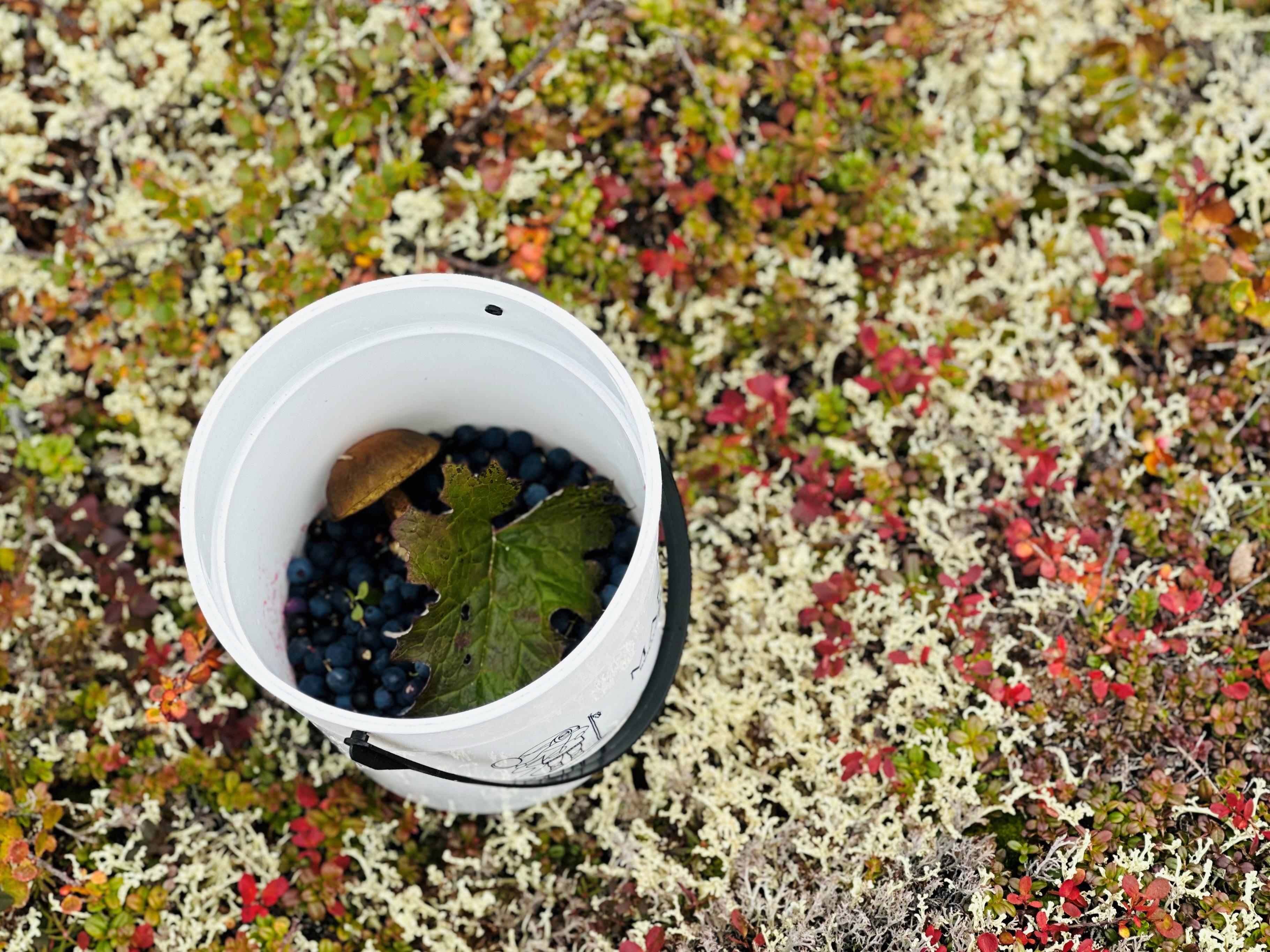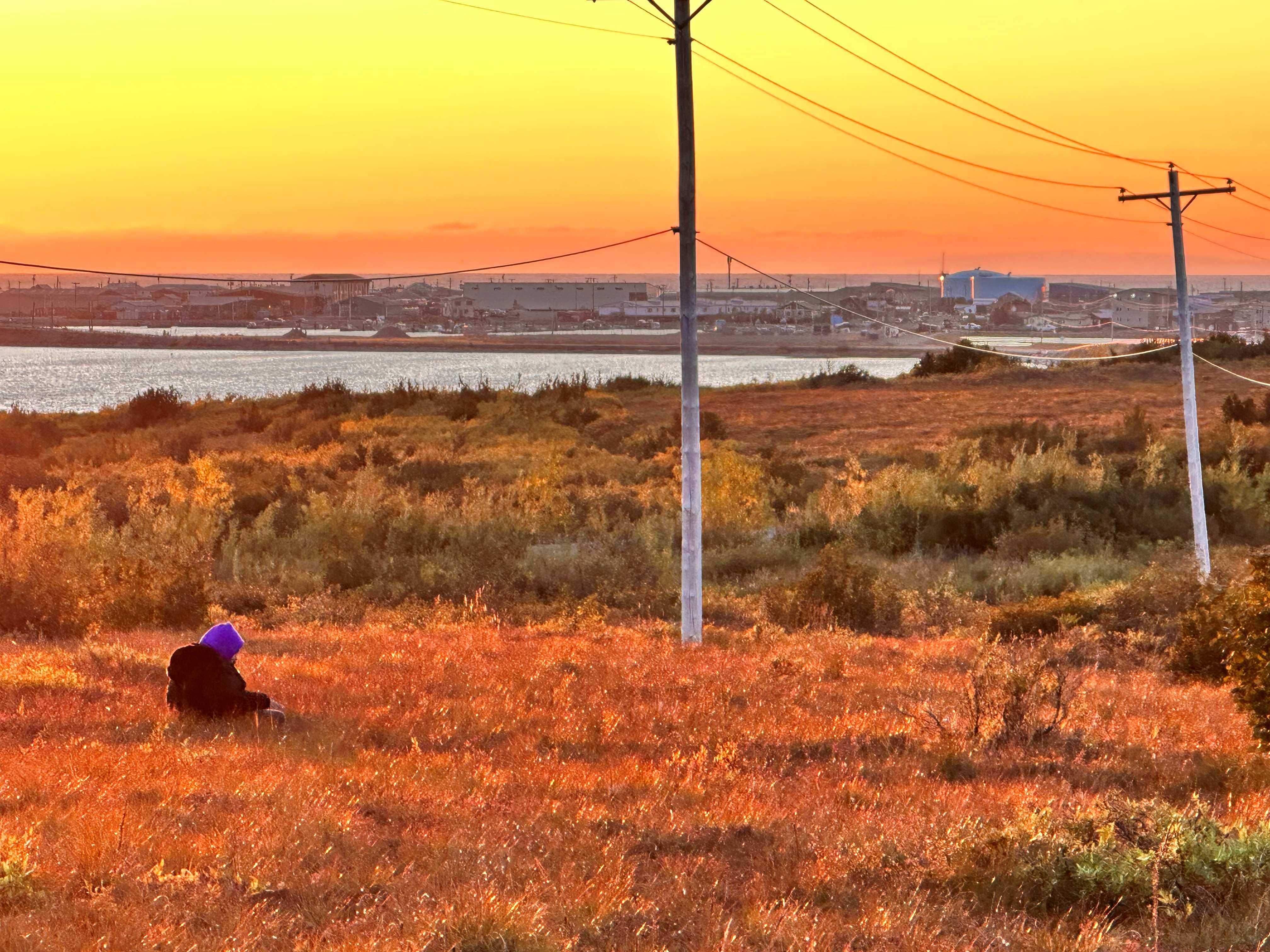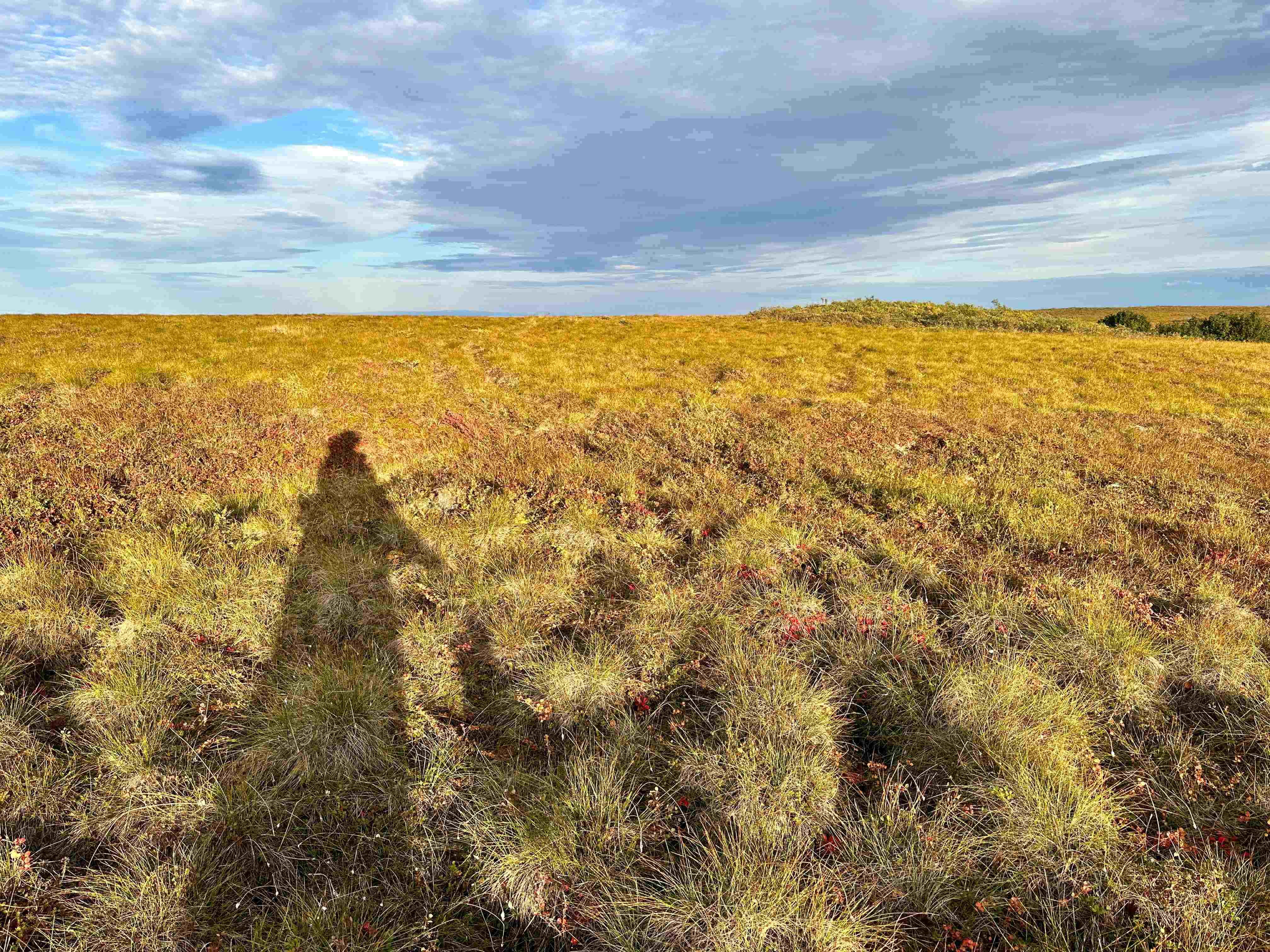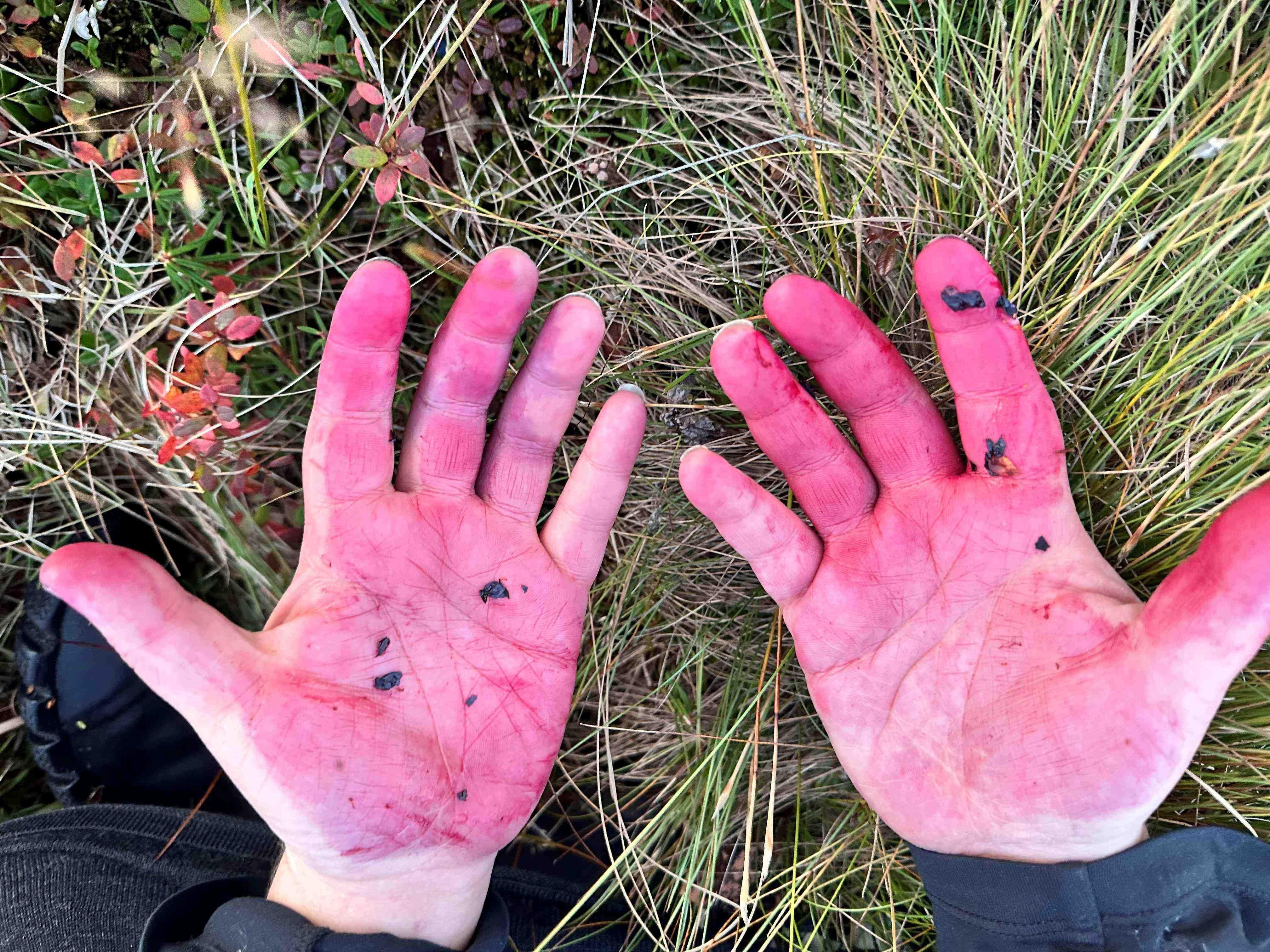
A bucketful of blueberries with bolete mushroom and coltsfoot leaf. Desiree Hagen

A bucketful of blueberries with bolete mushroom and coltsfoot leaf. Desiree Hagen
By Desiree Hagen
Winter 2024-25, FORUM Magazine
THE CRISP AIR electrifies my exposed cheeks. It's just after the equinox in mid-September, on the hills above Kotzebue. One cold hand sweeps the copper-colored tundra floor pulling long strands of cranberries in one motion into my plastic bucket. My goal is to pick two pints of cranberries, which might take a couple of hours or so.
Earlier that day, I joked with a friend’s 93-year-old Ahna (the Iñupiaq word for grandmother).
“You go pick?” she asked from her wheelchair.
“Yes, Ahna. You need berries? I’ll pick for you.” I feel like I had to warn her about my picking style – I don’t clean the berries while I’m out, so I often come back with a bucket full of twigs, leaves, and lichen along with my berries.
“I'll bring you an entire salad,” I say. She mishears me but it doesn’t matter.
“Oh, you bring entire sanŋit?” She grins. The joke works in both Iñupiaq and English, sanŋit means greens, leaves, or maybe tundra duff. She asks if I plan to bring her the entire tundra.
Ahna’s grandson - my friend - is gay. He’s closeted to many people in town including her. He says it would hurt his Ahna’s heart, even though some days he says, ‘I think she knows.’ When I berrypick with him, he seems more himself. He wears a feminine, colorful Russian scarf tied over his hair, but only when he berry picks. If a car drives by and we are in view of a road, he always tries to hide himself from their view.
“They’ll probably think I’m an elder with this scarf. I don’t want them to try to steal my spot,” he says.

Sunset on the hill overlooking Kotzebue Desiree Hagen
According to Ahna, now is the best time to pick cranberries – after the second fog in the fall time, when the fog clings low and close to the ground. Many people wait until after a frost before they begin to think about picking cranberries.
There are several unspoken laws to picking. One I adhere to is never picking close to a road or trail. It's important for me to hike a bit and leave the closer, easier spots for elders. The more time I spend out, the more I understand the sacredness of the tundra. We who live here must share and protect it.
There's a taboo about disclosing a berry-picking spot. More than once, a friend has taken me to their special berry picking spot. ‘Ah yes,’ I think, ‘the secret spot, right by one of the six or so spruce trees in Kotzebue. Surely no one would use that particular tree as their landmark.” Three friends have all taken me there, claiming it as “their spot” and making me promise that I tell no one.
I feel healthier when I am berry picking. I have started to associate my time outdoors with my own queerness, identity, and radical honesty.
My favorite berry picking spot is far enough away from town that I have to ride my fat bike to get there. It’s just past where my cell service ends – a wonderful reprieve for me, as a reporter, who often feels chained by constant communication.
The spot is near a large pond. Erosion and permafrost thaw have cut the ground into tiers within the last couple of years leaving concentric circles leading toward the water’s edge. I imagine from the other side of the pond, it would look like uneven, terraced rice fields, though with more autumnal colors. Exposed faint purple and gray earth from the permafrost slumping has a unique smell, like wet autumn and vague rot. Here in the rapidly changing Arctic, I am struck by how aesthetically beautiful some of the effects of climate are.
The eroding soil is difficult to maneuver. On the tundra while picking I feel more animal-like, scrambling on all fours, sometimes sliding, other times grasping willows or blueberry bushes for bracing. I exert muscles I forget exist, only becoming aware of their presence when they ache the next morning.

Author shadow with berry bucket. Desiree Hagen
While berry-picking my senses become acute, attuned to any intruders or animal residents who might surprise me. My eyes scan the ground for grizzlies, foxes, or ptarmigan, then toward the sky for migrating sandhill cranes, snow geese, or bush planes in the distance. Sometimes my gaze shifts, as if I am wearing special glasses hyper-focused to only recognize the familiar pattern and color of berry clusters.
I have never seen anyone else picking there, which is both unsettling and refreshing. I find the fattest berries, closest to the water, and often aqpiks (cloudberries), blueberries, and blackberries/crowberries still ripe this late in the season. It’s another sign that no other human has been here picking. Perhaps they are afraid of the bears, which I have seen evidence of through prints and scat- but never personally witnessed. I typically evaluate the evidence, questioning how long it’s been since they were in this same spot.
In the hours spent alone picking, I play out scenarios of what I would do if I encountered a grizzly. My main tactic would be to not make any motion that could confuse the bear into thinking I was prey. The closer I am to the water, the more I am hidden in natural alcoves. No one passing on the trail or road leading here could see me if I was hurt.
Within the tiered layers, I reach high to pick at the ground above me. Twigs and leaves become stuck in my hair, which I find after I am done picking – unintentionally bringing the suŋaaq with me, again.
I feel healthier when I am berry picking. I have started to associate my time outdoors with my own queerness, identity, and radical honesty.
Occasionally over the years, one leg has sunk knee-level or higher into icy water hidden by mats of tundra moss. I usually step into the same spot with my other leg so they will both be equally cold and wet. The last time this happened, earlier this year, it was so freezing. The lower half of my body felt like it was going into shock. Once I pulled myself out of the cold mud, I lay on my back and stared at the sky until a range of emotions - predominantly anger at myself- melted away.
My Iñupiaq teacher told me, “Make sure you always lie down on the tundra. This is the best medicine.” We were talking about Jesus and prayer at the time - how she was so thankful that I found an affordable place to rent so I could continue to live in Kotzebue facing, like many places in rural Alaska, a housing crisis. Based on our conversation my assumption was that for her berry picking was like a religious experience.
Berry picking can feel spiritual for me too, but I think my primary feeling is self-actualization – which is the top crown on Maslow's “Pyramid of Needs.” I feel most myself when I am away from a manufactured world.
Recently someone talking about architecture said something that stuck with me: “Stories are perpetuated through the built environment.” It made me think about how structures can confine us; how their uniformity can stifle us. It makes me wonder how much being indoors – which I associate with my job and professional persona – changes my thought patterns and perceptions of myself. And if this is detrimental to my mental health.

Author's hands after picking blueberries. Desiree Hagen.
This year Kotzebue celebrated its first Pride parade. While many people were supportive, several community members objected to the event publicly. One of the more tired and inaccurate statements I heard repeated on social media posts was that non-heterosexual expressions of sexuality are “unnatural.”
It makes me wonder how much time the people who said those things have spent in nature. Many of the animals here in the Northwest Arctic have been documented as having homosexual behavior — including caribou, beluga and bowhead whale, Dall sheep, fox, wolves, grizzly bears, moose, musk-ox, spotted and bearded seals. Many of those animals are staples in our freezers and drying racks. Recent studies have found that scientific research in the last 300 years on homosexual behavior in animals was often downplayed, glossed over, or not published.
Beluga whales have been documented as having both male and female reproductive parts. Birds on the tundra adopt various traits that as humans we could perceive as non-heteronormative or gender non-conforming. Female phalaropes - a common Arctic bird about the size of a robin - can be quite polyamorous, with multiple partners simultaneously. The females are colorful - which is different than many bird species. Male phalaropes also have a reversed role: males incubate eggs and care for the young birds once they’ve hatched.
Here crouched on the damp carpet of thick tundra moss, a flock of sandhill cranes catches my attention. They are flying in the opposite direction of the lingering light, as dusk sets in. Soon the berries will be too difficult to see, and it's still a several-mile bicycle ride back into town. Gathering my things, I admire my bucket picking out the twigs from about a quart of crimson berries. I can feel some of the leaves in my hair too, but I’m not worried about it. I don't mind bringing a little bit of tundra back with me. ■
Desiree Hagen is a journalist living and working in Kotzebue. She gains inspiration from the potency, resilience, strength of Arctic plants, animals and residents. She hopes her work mirrors it. Desiree is a 2024 FORUM Writing Fellow.
FORUM is a publication of the Alaska Humanities Forum. FORUM aims to increase public understanding of and participation in the humanities. The views expressed by contributors are not necessarily those of the editorial staff or the Alaska Humanities Forum.
The Alaska Humanities Forum is a non-profit, non-partisan organization that designs and facilitates experiences to bridge distance and difference – programming that shares and preserves the stories of people and places across our vast state, and explores what it means to be Alaskan.
October 26, 2025 • Chris Koonce
October 9, 2025 • Eiden Pospisil
October 1, 2025 • Liliane Ulukivaiola